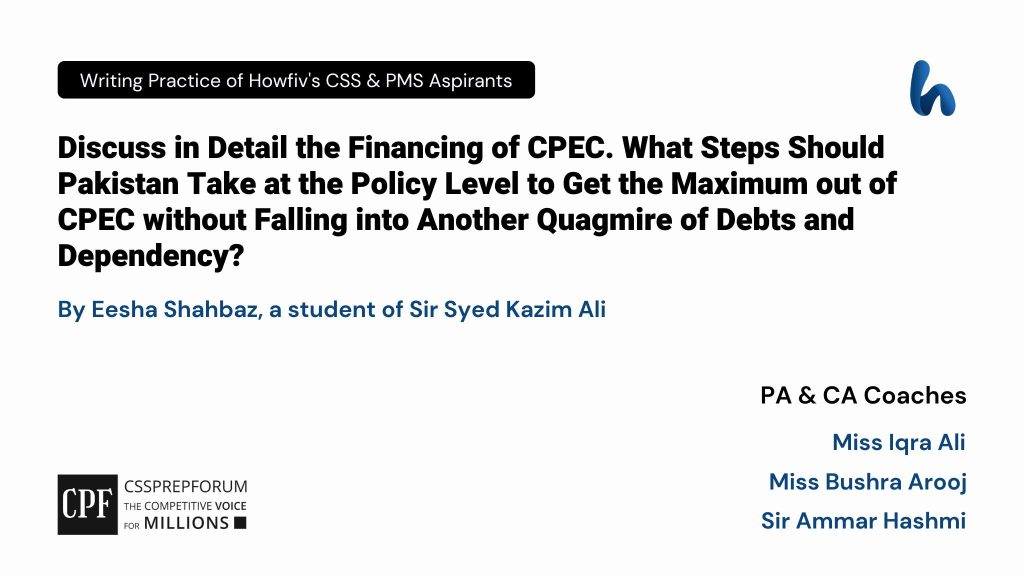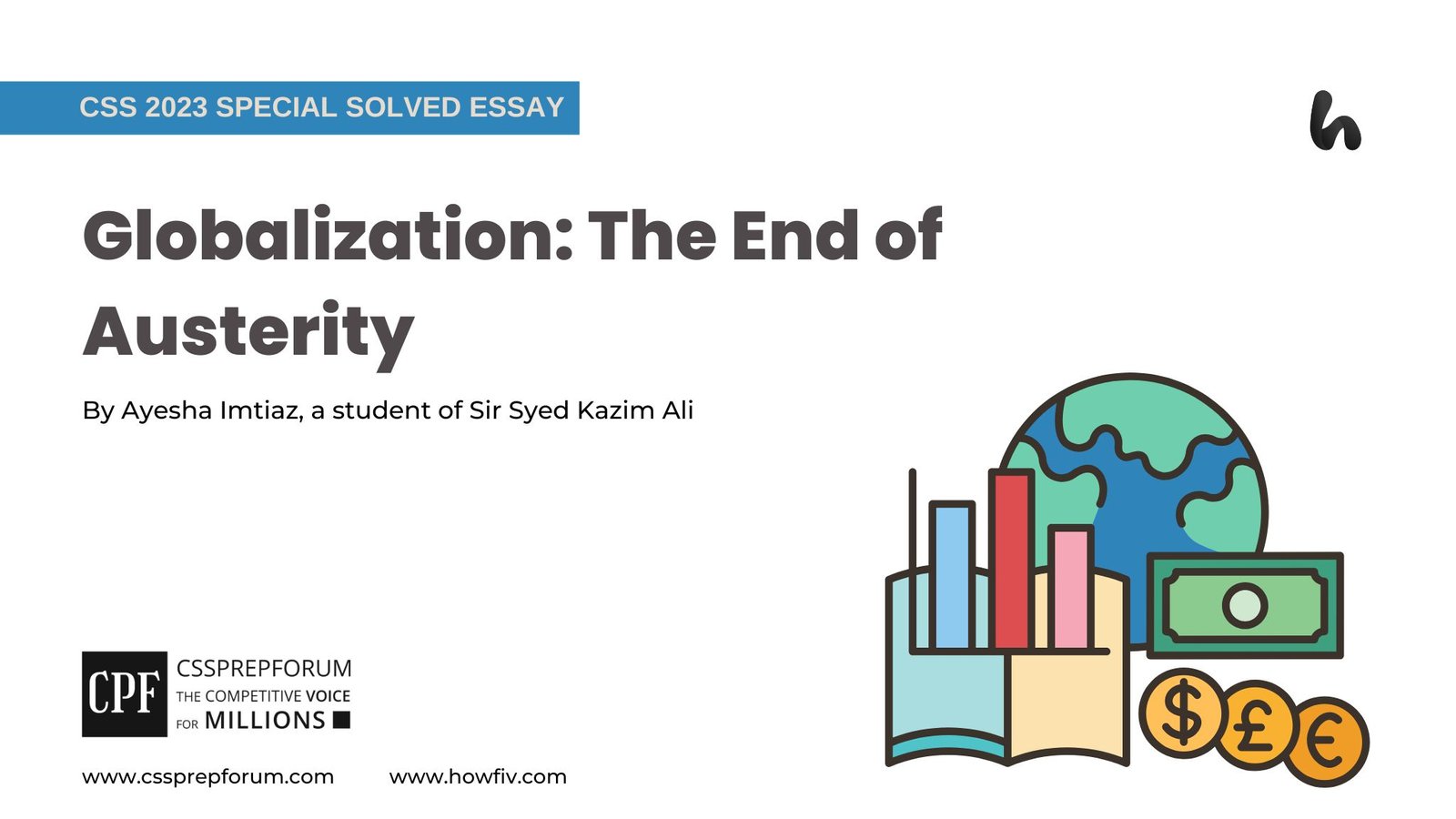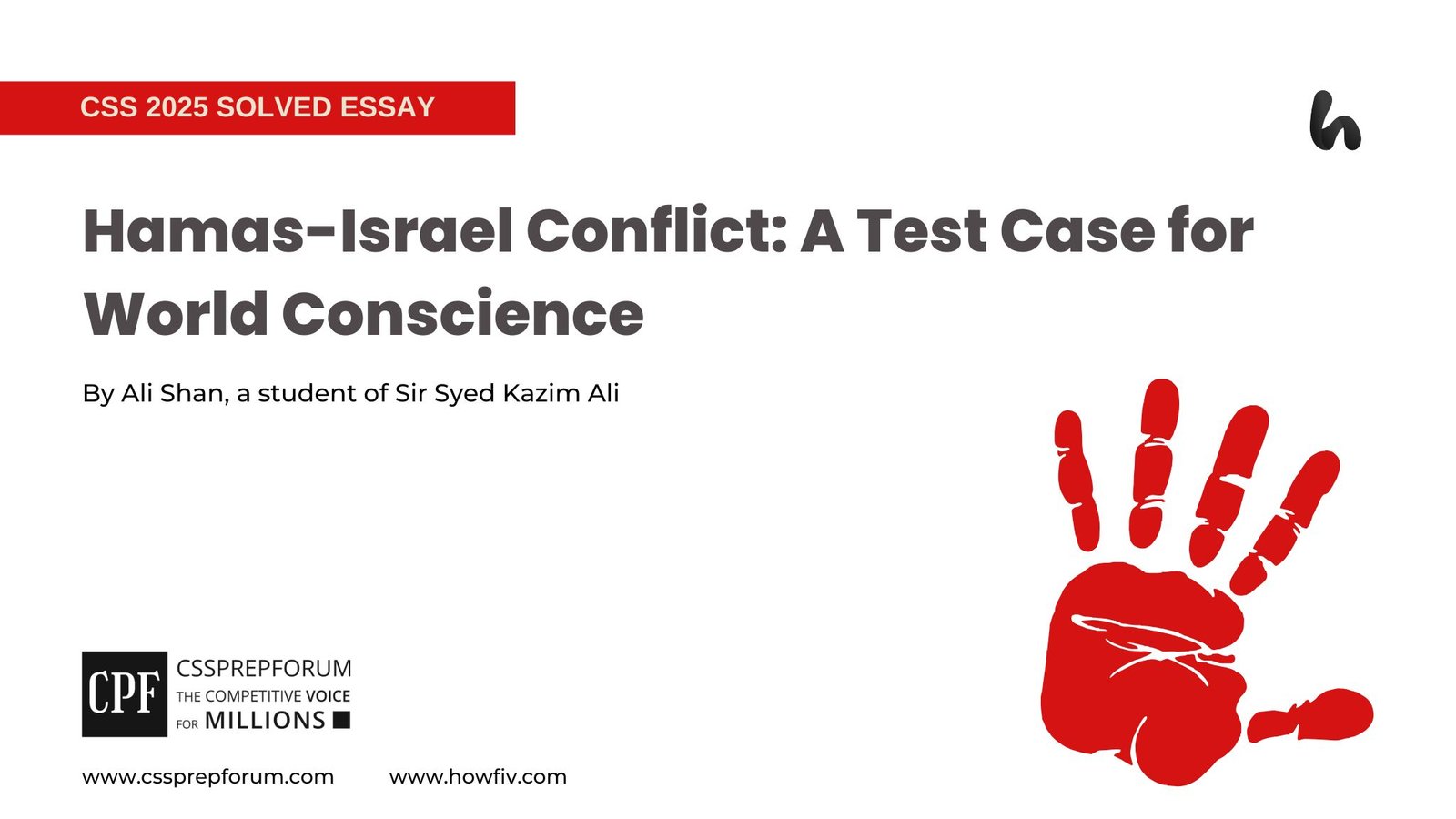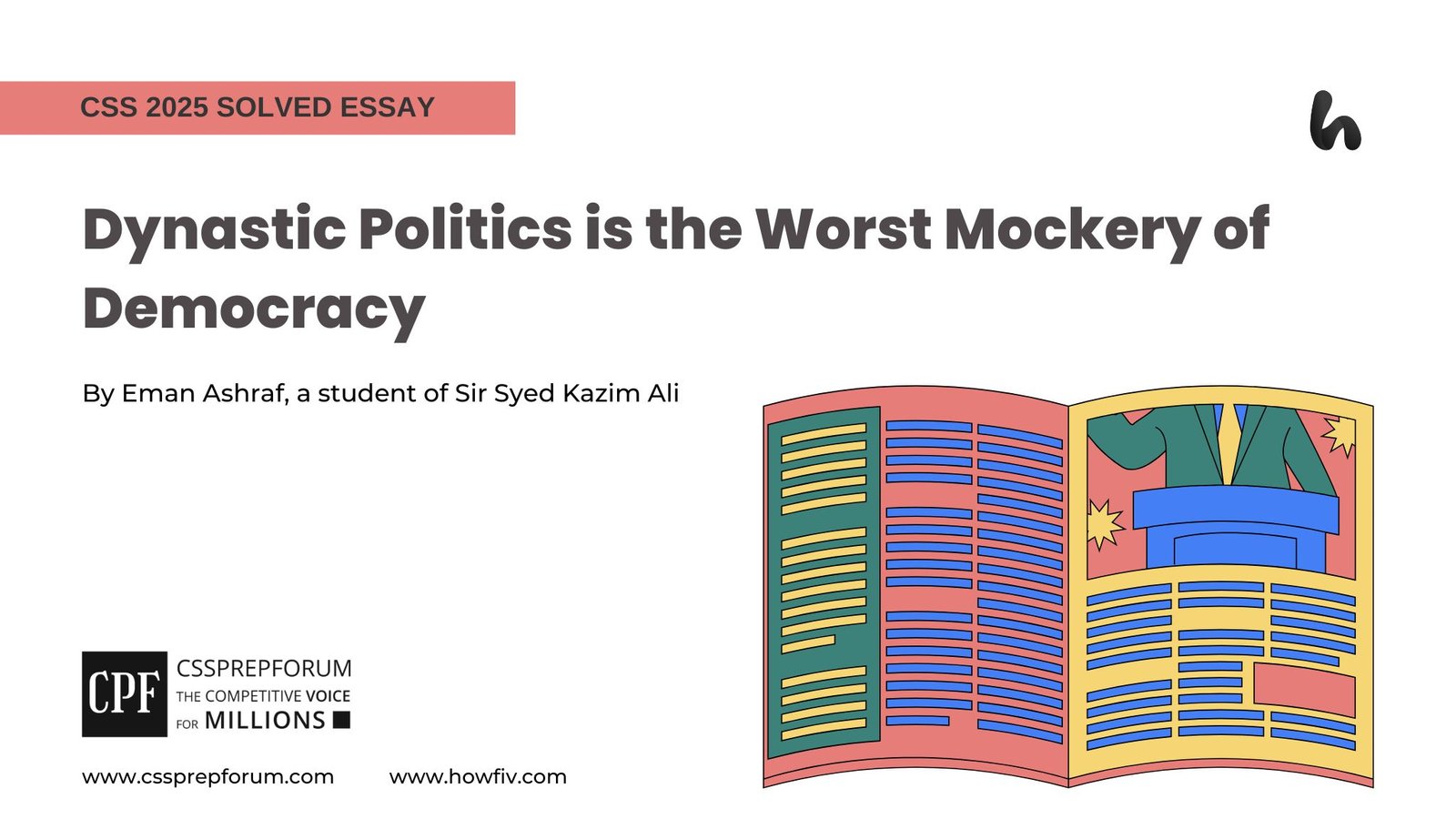CSS Pakistan Affairs | Financing of CPEC and Suggestions for Pakistan
The following question of CSS Current Affairs is solved by Eesha Shahbaz under the supervision of Howfiv’s Pakistan Affairs and Current Affairs Coaches. She learnt how to attempt 20 marks question and essay writing from Sir Syed Kazim Ali, Pakistan’s best CSS and PMS English essay and precis teacher with the highest success rate of his students. This solved past paper question is attempted on the pattern taught by Sir to his students, scoring the highest marks in compulsory and optional subjects for years, and uploaded to help aspirants understand how to crack a topic or question, how to write relevantly, what coherence is, and how to include and connect ideas, opinions, and suggestions to score the maximum.

Outline
1-Introduction
2-An Overview of the financing of CPEC
3-Phases of CPEC investment
- ✓The Energy Portfolio: IPPs and Foreign Investment
- Foreign investment
- Debt Servicing
- ✓Chinese Commercial Banks
- ✓Asian Development Bank
- ✓Other Major Contributors
- ✓Joint Ventures of Chinese and Pakistani Companies
4-Steps Pakistan should take at the policy level to get the maximum out of CPEC
- ✓Reform Energy Policies
- Need for Distribution Companies (DISCOs) reforms
- Cost reduction for the end users
- The role of National Transmission and Dispatch Company (NTDC)
- ✓Change in Industrial Policies
- Equal access and incentives
- Land allotment and lease policies
- Provision of local investors
- ✓Betterment in Trade Policies
- Pressure on current accounts
- Exchange rate management
- ✓Change in Financial Policies
- Addition of finances for Pakistani companies
- Support for small and medium enterprises
5-Critical Analysis
6-Conclusion

Answer to the Question
Introduction
China-Pakistan Economic Corridor, a flagship project of the Belt Road Initiative, is a multi-billion project that aims to enhance connectivity between Pakistan and China and also to give China an alternate trade route to the Middle East. The financing structure of this dynamic project is a combination of multiple investors and banks, including concessional loans, commercial loans, equity investments, and grants provided primarily by Chinese state-owned banks and commercial entities. However, CPEC raises concerns about the potential debt accumulation, economic dependencies, and long-term sustainability. It is believed that the rising debts would rob the potential of CPEC and engulf the country in a debt trap. Despite the economic opportunities it holds for the country, a lack of pragmatic efforts and policy reformations would lead the state into shambles. The government should revive energy, infrastructural, financial, and trade policies to get the maximum out of CPEC. As a result, the country can enjoy the due promises CPEC holds and enter into a new of economic instability. Thus, adopting the aforementioned measures can surely help Pakistan to make CPEC a game-changer for its economy.
An Overview of CPEC
The China-Pakistan Economic Corridor is one of the mega belts of China’s global infrastructure development project, the Belt Road Initiative. It is rightly known as the flagship because it aims to connect neighbourhoods of East and West Asia, holding unique opportunities for both Pakistan and China. The initiative is part of China’s broader Belt and Road Initiative (BRI) and involves a network of roads, railways, pipelines, and energy projects designed to connect Gwadar Port in Pakistan’s Balochistan province with China’s Xinjiang region. This answer sheds light on the financing of this multi-dimensional project and steps that can help Pakistan gain the maximum benefit from CPEC without leading to crutches of debt and over-dependence on China.
Two Phases of CPEC Investment
The total committed amount under CPEC is divided into two broad categories. The implementation schedule of these projects would determine the payment streams. Energy projects were planned for completion by 2020, but given the usual bureaucratic delays, it won’t be before 2023 that all projects are fully operational. Under the early harvest programme, 10,000 MW would be added to the national grid by 2018. Therefore, the disbursement schedule of energy projects is eight years (2015‐2023). Moreover, the infrastructure projects, such as Infrastructure projects such as roads, highways, and port and airport development, amounting to $10bn, can reasonably be expected to be concluded by 2025, while the remaining projects worth $ 5bn would spill over into the 2025‐30 period.

- IPP Energy Portfolio:
The entire energy portfolio will be executed in the Independent Power Producers (IPP) mode, applicable to all private power producers in Pakistan.
- Foreign Investment
Foreign investors’ financing will be classified under Foreign Direct Investment (FDI). Foreign investors are guaranteed a 17% rate of return on their equity in dollar terms. This guarantee applies only to the equity portion and not to the entire project cost. Loans for these projects will be taken by Chinese companies, primarily from the China Development Bank and China Exim Bank. - Debt Servicing
Chinese companies will service the debt from their own earnings, with no financial obligation on the part of the Pakistani government.
- Chinese Commercial Banks
Commercial banks of China hold 30 per cent of Pakistan’s total investment in CPEC projects. Commercial banks, including the Export-Import Bank of China (China Exim Bank), China Construction Bank (CCB), China Development Bank (CDB), Industrial and Commercial Bank of China (ICBC), and others have contributed to CPEC projects. More than $10 billion are invested in the CPEC project in Pakistan by state-owned Chinese lenders operating as official financing arms for China’s Belt and Road Initiative. Pakistan owed a bilateral debt of 80 per cent to Beijing.
- Asian Development Bank:
Asian Development Bank is another largest bilateral creditor with extending outstanding loans of $14.5 billion. However, this number undercounts the true extent of Chinese lending to Pakistan in other categories. For instance, China’s SAFE (State Administation of Foreign Exchange) has lent to Pakistan. The Economic Survey lists $7 billion owed to SAFE/TIME, which likely includes loans extended by SAFE. For instance, ML-1 (Main Line-1) Railway Project that extends from Karachi to Peshawar is financed by concessional loans from Chinese institutions, including SAFE with worth of $6.8 billion.
- Other Major Contributors:
Commercial banks, including West Asia and three Chinese lenders: the Bank of China, China Development Bank, and all other State-owned Banks are also involved in contributing major projects in CPEC. Chinese state‐owned companies, designated by the Chinese government based on their expertise and experience, are executing the projects with loans provided by government‐ owned banks on concessional terms both in tenor and pricing. For instance, the Karot Hydropower project on Jhelum River in Pakistan’s Punjab province is financed by China Exim Bank, a government-owned bank, offering concessional loans with favorable interest rates and extended repayment periods.
- Joint Ventures of Chinese and Pakistani Companies:
There are several joint ventures between Chinese and Pakistani companies under the China-Pakistan Economic Corridor (CPEC) framework. These joint ventures focus on sectors such as energy, infrastructure, and industrial development. For instance, a Pakistani company, Huaneng Shandong Ruyi Energy Ltd. and Chinese company China Huaneng Group are working together on Sahiwal Coal Power Project.
Steps Pakistan Should Take at the Policy Level to Get the Maximum Out of CPEC
If Pakistan wishes to take the maximum benefit from such a vast and golden opportunity CPEC, policies should be revived at all the levels that would surely take Pakistan into a new era of advancement in all its sectors. The following suggestions can help Pakistan reform and strengthen its policies and walk towards the road of progress.
- Reforms in Energy Policies:
First of all, Pakistan should begin working on energy policies, considering the below mentioned ways:
- Need for DISCOs’ (Distribution Companies) Reform:
The addition of 10,000 MW to the National Grid by 2018 is expected to overcome energy shortages; however, there may be unintended adverse effects on public finances and the liquidity of companies involved in the energy supply chain if other components of energy policy are not addressed. The existing issue of circular debt could worsen if the gap between the purchase price of power paid by the Distribution Companies (DISCOs) and the sale revenues collected by them is not closed. Unless DISCOs are privatized or restructured into commercial entities free from political interference, the growing circular debt could widen the fiscal deficit. Reforming the Distribution companies policies can help Pakistan get over the shortcomings in energy policies, ultimately leading to the multitude of benefits. - Cost Reduction for End Users:
The second most important thing is the reduction in cost of electricity generation to end users by establishing competitive energy markets and energy exchanges, holding auctions for tariff determination, and introducing multiple buyers instead of the current single-buyer model. - The Role of National Transmission and Dispatch Company:
Pakistan can gain benefits by reviving the role of The National Transmission and Dispatch Company (NTDC) in energy sector. The NTDC would recover only the wheeling charges for the use of its transmission infrastructure, ultimately leading to a better outcome.
- Changes in Industrial Policies
After energy policies, Pakistan should work on the following industrial policies that would help Pakistan get the maximum benefits from CPEC.
- Equal Access and Incentives:
Special Economic Zones (SEZs) and Industrial Parks along the Corridor should be open to Pakistani firms on the same terms as Chinese firms. In addition, any incentives provided to Chinese investors should be equally applicable to all investors. - Land Allotment and Leasing Policies
Land is to be allotted on a long-term lease rather than outright purchase. Leases should be auctioned only to genuine, pre-qualified, and screened bidders to eliminate land grabbers and speculators. The lease should include a provision that land allotment will be canceled if the project is not operational within three years. - Provisions for Local Investors
In Balochistan, some land should be reserved for local investors, wherever feasible, without the right of alienation. Moreover, all infrastructure works, including power, gas, water, roads, effluent plants, and amenities, should be in place before possession is handed over.
- Betterment in Trade Policies:
Another most important thing is to bring change in trade policies by identifying the existing shortcomings that would also help Pakistan gain the due and promised benefits of this great venture, CPEC.
- Pressure on Current Account:
External payments for repatriation of profits and debt servicing of CPEC projects would put pressure on the Current Account. Exports need to grow at least 15 percent annually to meet these new obligations. Moreover, remittances must increase at their historical levels. - Exchange Rate Management:
The exchange rate needs to be managed deftly to stimulate new export products, new firms, and market penetration. Care must be taken to ensure that import prices for capital goods, machinery, and equipment do not rise to the point where new investments become unattractive.
- Changes in Financial Policies
Last, change in financial policies can serve to be another major step that can help Pakistan make CPEC a game changer for its socio-economic progress.
- Financing for Pakistani companies:
Commercial banks should finance Pakistani companies, either independently or in joint ventures with Chinese companies. The Infrastructure Development Fund should collaborate with banks to scrutinize proposals, calculate future cash flows, and perform scenario analysis for risk mitigations. - Support for small and medium enterprises:
Existing funds set up by DFID, USAID, etc., should be enhanced to meet the demand from small and medium enterprises working as subcontractors, providing goods and services for CPEC projects, or starting new businesses.
Critical Analysis
The above-mentioned policy reformations can help Pakistan be less dependent on China and strengthen its geopolitical and socio-economic standing in the world. This initiative by China can be game-changer for Pakistan as it holds multitude of benefits in all the spheres; this would help Pakistan attract foreign investment and boost its local economy as well. If Pakistan wishes to prosper the benefit CPEC beholds, the government must take pragmatic measures to reform the policies and implement them to ensure Pakistan march towards success.
Conclusion
In a nutshell, CPEC is a vast project full of benefits that have the power to revive Pakistan’s economy and promote regional connectivity. However, maximizing these benefits requires strategic reforms in energy, industrial, trade, and financial policies. By addressing challenges such as debt servicing and foreign exchange management, Pakistan can ensure sustainable growth and economic stability. Effective policy implementation will be crucial for realizing the full potential of CPEC in driving long-term development.

CSS Solved Past Papers’ Essays
Looking for the last ten years of CSS and PMS Solved Essays and want to know how Sir Kazim’s students write and score the highest marks in the essays’ papers? Then, click on the CSS Solved Essays to start reading them.
CSS Solved Essays
CSS Solved Islamiyat Past Papers
Want to read the last ten years’ Islamiyat Solved Past Papers to learn how to attempt them and to score high? Let’s click on the link below to read them all freely. All past papers have been solved by Pakistan’s top CSS Islamiyat coach having the highest score of their students.
CSS Solved Islamiyat
CSS Solved General Science & Ability Past Papers
Want to read the last ten years’ General Science & Ability Solved Past Papers to learn how to attempt them and to score high? Let’s click on the link below to read them all freely. All past papers have been solved by Pakistan’s top CSS GSA coach having the highest score of their students.
CSS Solved General Science & Ability











